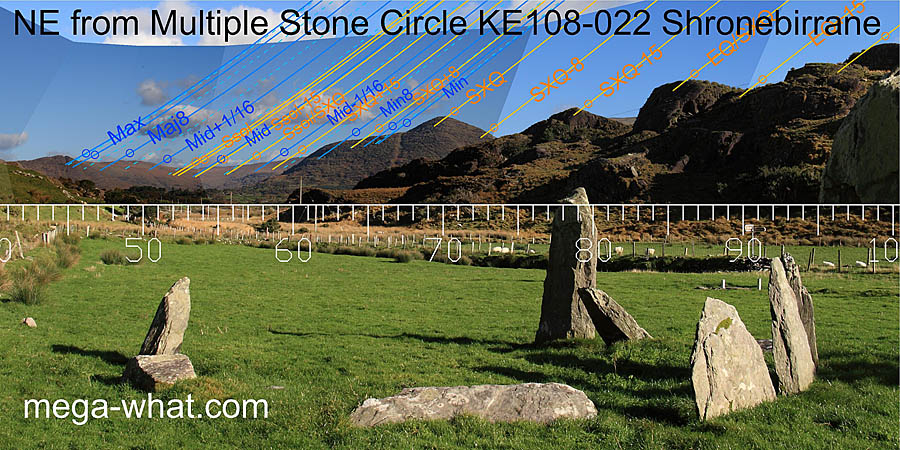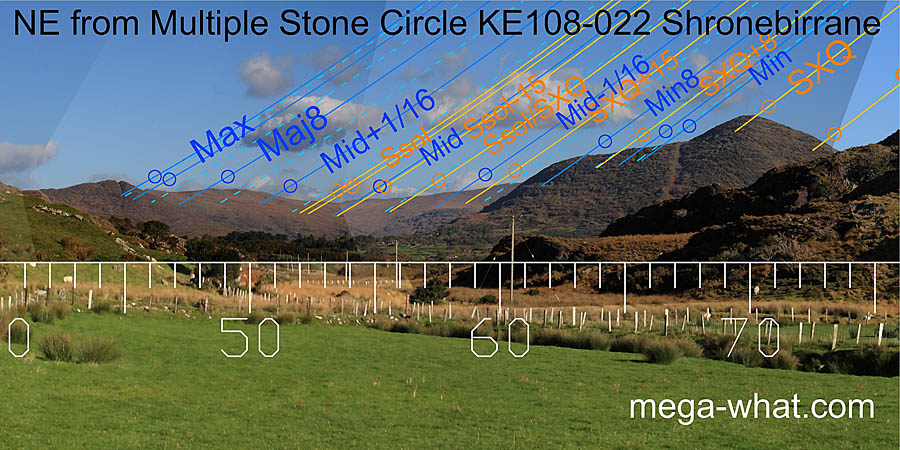 Shronebirrane Stone Circle is in a lovely spot on the west bank of the Drimminboy River.
A thirteen stone circle, about 7.5m in diameter, with ten stones present. Parking is provided and a small fee is payable.
Shronebirrane Stone Circle is in a lovely spot on the west bank of the Drimminboy River.
A thirteen stone circle, about 7.5m in diameter, with ten stones present. Parking is provided and a small fee is payable.
The view across the circle from the axial stone is in the general direction of the summer cross-quarters (Bealtaine & Lughnasadh).
The axial stone is a wide but thin slab that now leans strongly inwards. The eastern arc of five sidestones and portal is complete though one stone is fallen. The western central sidestone is still upright. Two between it and the axial are not.

 The eastern horizon is very useful. Summer cross-quarter / equinox midpoint is on a hilltop and the exact position of a local hill is critical to the marking of the equinox.
The eastern horizon is very useful. Summer cross-quarter / equinox midpoint is on a hilltop and the exact position of a local hill is critical to the marking of the equinox.
Winter cross-quarters are bracketed rather than marked. No lunisticesLunistices are the most northerly and southerly moons of the month. The lunar equivalent of solstices - more. are visible but backing up the slope behind the circle could make this notch a very sensitive indicator for the minor standstillLunistice positions vary cyclically over an 18.6 year period but are fairly static for more than a year at either end of the range at least.

 South is indicated by a hilltop but is right of it, with the high horizon cutting off many rises and sets.
Its profile gives high precision to the half-month south of the winter cross-quarter, which itself has a good mark on the western side.
The month centred on the solstice is also very precise as are the lunar midpoint and
minor standstillLunistice positions vary cyclically over an 18.6 year period but are fairly static for more than a year at either end of the range.
South is indicated by a hilltop but is right of it, with the high horizon cutting off many rises and sets.
Its profile gives high precision to the half-month south of the winter cross-quarter, which itself has a good mark on the western side.
The month centred on the solstice is also very precise as are the lunar midpoint and
minor standstillLunistice positions vary cyclically over an 18.6 year period but are fairly static for more than a year at either end of the range.

 The height of the western horizon moves everything further south than usual but the rocky profile provides many useful markers.
The height of the western horizon moves everything further south than usual but the rocky profile provides many useful markers.

 The western axis of the circle is in the general direction of the equinox / summer cross-quarter midpoint. North is accurately indicated by a hilltop.
The western axis of the circle is in the general direction of the equinox / summer cross-quarter midpoint. North is accurately indicated by a hilltop.
- Cashelkeelty Stone Circles and Stone Row are just over the ridge, 2.25km to the NNW as the crow flies.
- Drombohilly Stone Circle is c.7km NNE.
References
- Archaeological Survey of Ireland, record details. www.archaeology.ie/archaeological-survey-ireland
- BYRNE, ELIZABETH, et.al. 2009 Archaeological Inventory of County Kerry, Volume 1: South West Kerry. Dublin: Stationary Office. p19, no.73.
- Ó'NUALLÁIN, SEÁN 1984 A Survey of Stone Circles in Cork and Kerry. Proceedings of the Royal Irish Academy 84c:1-77: no.46, p29 & fig 2.
- RUGGLES, C.L.N. 1999 Astronomy in Prehistoric Britain and Ireland. Newhaven & London: Yale University Press. No. ASC33.


